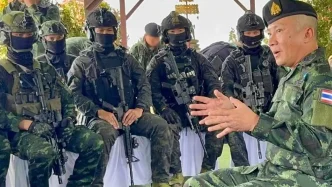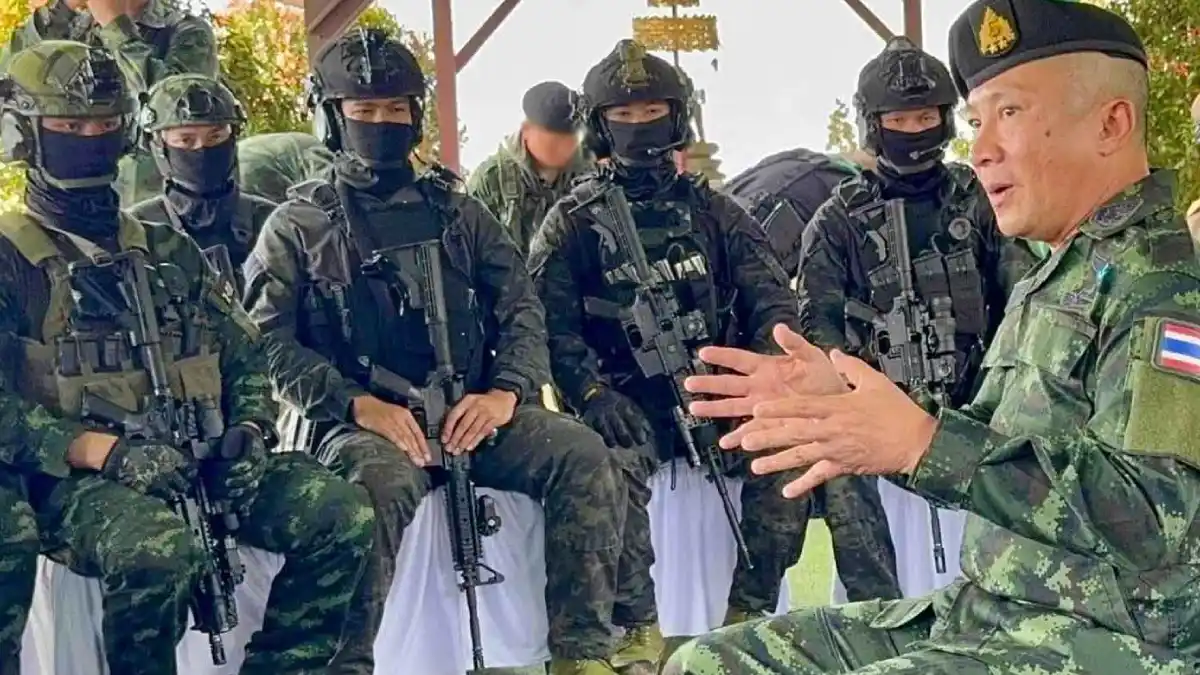Thailand and Cambodia stand at a critical juncture as border crossings, vital for trade and travel, remain partially shuttered. At the heart of the issue is the Poipet International Border Checkpoint in Banteay Meanchey province, a key conduit between the two nations, where restricted operating hours and differing policies have sparked debate over access and coordination. As Thailand insists it has not closed its borders—only adjusted hours for practical reasons—questions linger about Cambodia’s stance and the broader implications for regional stability and economic ties.
Border Hours: A Misalignment of Policies
Thailand’s Chief of Defence Forces, General Songwit Noonpackdee, recently clarified the country’s position on border operations during a media address in Chiang Rai province on July 12, 2025. Speaking from the Doi Chang Moob operations base, General Songwit emphasized that Thailand has maintained access at checkpoints like Poipet, operating them from 8 a.m. to 4 p.m. daily. “We have never closed the checkpoints” he stated, as reported by local sources on July 13, 2025. He pointed out, however, that Cambodia has restricted access on its side along the entire border, creating a mismatch in operational hours that hinders movement.
General Songwit, who also directs the center for the prevention and resolution of security threats along border areas, proposed synchronizing hours—potentially extending them to 6 p.m.—to facilitate freer movement. This suggestion comes amidst growing calls to reopen crossings fully, a move seen as essential for reviving cross-border trade and travel disrupted by the current limitations. The general’s remarks reflect a pragmatic approach, acknowledging the logistical challenges while pushing for a collaborative solution.
The border issue gained attention following a report from the Second Army Region commander, Lieutenant General Boonsin Padklang, on July 11, 2025. According to General Songwit, military communication between Thailand and Cambodia has improved, with joint patrols now occurring three times a week. This development signals a willingness to cooperate, yet the fundamental question of border access remains unresolved. For communities and businesses on both sides, the stakes are high, as restricted hours limit economic activity and personal mobility in a region historically reliant on cross-border exchanges.
Humanitarian Exceptions Amidst Restrictions
Despite the operational constraints, Thailand has upheld humanitarian principles at the border, according to General Songwit. “We’ve allowed patients and schoolchildren who need to cross into Thailand to do so” he said during the same media address on July 12, 2025. He underscored the importance of education in fostering better relations between the two countries, framing continued access for students as a gesture of goodwill. “Our goal is to be good neighbors and maintain peace along the border” he added, highlighting Thailand’s commitment to stability despite the challenges.
This humanitarian stance offers a glimpse of hope for those affected by the border restrictions. In towns like Poipet, where families and communities straddle the divide, such exceptions provide critical lifelines. Students crossing for education and patients seeking medical care represent the human dimension of a geopolitical issue, reminding policymakers of the real-world impact of their decisions. Yet, these measures are stopgaps, not solutions, as broader access remains curtailed by the lack of synchronized policies.
Economic and Political Ramifications
The Poipet checkpoint, one of the busiest along the Thailand-Cambodia border, serves as a linchpin for regional trade. Its limited hours—coupled with Cambodia’s reported closure on its side—have disrupted the flow of goods and people, impacting local economies in Banteay Meanchey province and beyond. Small-scale traders, who rely on daily crossings to sell goods, face mounting losses, while larger businesses grapple with delays in supply chains. The economic toll extends to tourism, a vital sector for both nations, as travelers encounter barriers to entry that deter visits and stifle revenue.
Politically, the border issue tests the resilience of Thailand-Cambodia relations, which have historically oscillated between cooperation and tension. Past disputes over territory and cultural heritage—such as the Preah Vihear temple conflict—have left lingering sensitivities, making border policies a potential flashpoint. While joint patrols and improved military communication are positive steps, they do not address the core issue of access. Analysts suggest that Cambodia’s decision to close its side may stem from domestic security concerns or political considerations, though no official statement from Phnom Penh has been verified in this context.
For Thailand, maintaining an open stance—albeit with adjusted hours—serves both practical and diplomatic purposes. It positions Bangkok as a cooperative partner, keen on dialogue rather than confrontation. General Songwit’s call for synchronized hours could be a diplomatic olive branch, signaling readiness to compromise without conceding control over its borders. However, without reciprocal action from Cambodia, such proposals risk remaining rhetorical, leaving the border in a state of limbo.
Regional Context and Historical Precedents
The current border situation must be viewed within the broader context of Southeast Asian geopolitics, where land borders often reflect deeper historical and cultural divides. Thailand and Cambodia share a complex history, marked by territorial disputes and periods of strained relations, particularly during the 20th century. While the Association of Southeast Asian Nations (ASEAN) framework promotes regional unity, bilateral issues like border access often reveal the limits of such cooperation. ASEAN’s principle of non-interference means that disputes between member states are typically resolved bilaterally, placing the onus on Bangkok and Phnom Penh to find common ground.
Historically, border closures or restrictions in the region have been tied to security threats, political instability, or health crises. During the COVID-19 pandemic, for instance, many Southeast Asian nations, including Thailand and Cambodia, imposed strict border controls to curb the virus’s spread, with lasting impacts on cross-border communities. The current situation, however, appears less tied to a specific crisis and more to operational and policy differences, making it a unique challenge. Lessons from past reopenings suggest that dialogue, transparency, and economic incentives are key to resolution, but these require mutual trust—a commodity sometimes in short supply.
Public Sentiment and Community Impact
In border towns like Poipet, the human cost of restricted access is palpable. Residents who once crossed daily for work, family visits, or trade now face uncertainty, with limited hours creating bottlenecks and frustration. Images of closed gates at the Poipet checkpoint, captured on June 25, 2025, symbolize the broader barrier between the two nations—a physical and metaphorical divide that separates livelihoods and relationships. For many, General Songwit’s assurances of humanitarian access are a small comfort against the backdrop of broader restrictions.
Public sentiment, while not fully captured in verified data, likely mirrors the economic strain felt in these communities. Cross-border trade, often informal and small-scale, forms the backbone of local economies in regions like Banteay Meanchey. When checkpoints operate on limited schedules—or not at all on one side—the ripple effects touch everyone from market vendors to transport workers. The push for reopening, as voiced by General Songwit, aligns with these community needs, but its success hinges on Cambodia’s response, which remains unclear at this juncture.
The Path Forward: Challenges and Opportunities
Resolving the border issue demands a delicate balance of pragmatism and diplomacy. Thailand’s proposal to synchronize operating hours offers a potential starting point, but it requires Cambodia’s buy-in to be effective. Bilateral talks, perhaps facilitated by military channels already showing progress through joint patrols, could pave the way for an agreement. Economic incentives—such as the mutual benefits of revived trade and tourism—might also spur action, appealing to both governments’ interest in post-pandemic recovery.
Yet challenges abound. Domestic priorities in Cambodia, whether related to security or politics, may delay or complicate negotiations. Trust, eroded by historical tensions, remains a hurdle, as does the logistical task of aligning border policies without compromising sovereignty. For ASEAN, while direct intervention is unlikely, the situation underscores the need for stronger mechanisms to address bilateral disputes that impact regional stability.
As Thailand and Cambodia navigate this impasse, the border’s future remains uncertain. General Songwit’s insistence on openness and neighborly relations sets a constructive tone, but words must translate into action. Whether synchronized hours or a full reopening emerges as the solution, the outcome will shape not just the Poipet checkpoint but the broader dynamic between two nations bound by geography and history. For now, the gates may be partially open, but the path to seamless connection is still under negotiation.















